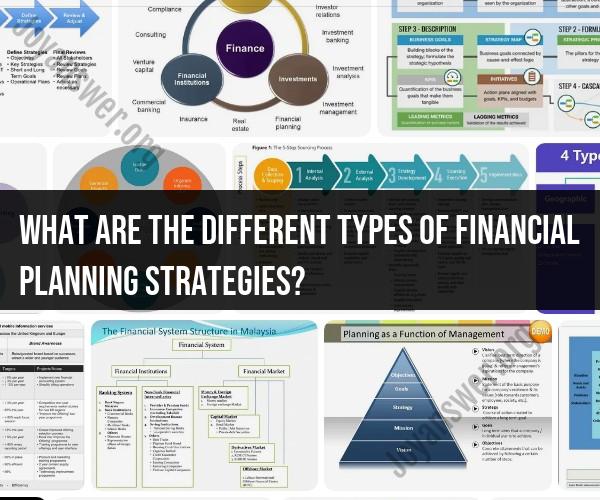What are the different types of financial planning strategies?
Financial planning strategies can vary depending on an individual's or organization's financial goals, circumstances, and preferences. Here are different types of financial planning strategies:
Wealth Accumulation Strategy:
- Focuses on saving and investing to build wealth over time. This strategy aims to increase assets through consistent savings, prudent investments, and compounding returns.
Debt Reduction Strategy:
- Prioritizes paying off debts efficiently, especially high-interest debts like credit card balances and personal loans. The goal is to become debt-free and free up more income for saving and investing.
Retirement Planning Strategy:
- Concentrates on preparing for retirement by saving and investing with the goal of achieving financial security during retirement years. This may involve contributing to retirement accounts, such as 401(k)s and IRAs.
Emergency Fund Strategy:
- Emphasizes building an emergency fund to cover unexpected expenses or financial crises. The strategy aims to provide a financial safety net, reducing the need to rely on credit during emergencies.
Tax Planning Strategy:
- Focuses on optimizing tax efficiency in financial decisions. This may involve strategies like tax-advantaged retirement contributions, tax loss harvesting, and deductions.
Estate Planning Strategy:
- Involves creating a plan for the distribution of assets after death. Estate planning may include drafting a will, setting up trusts, and designating beneficiaries for accounts.
Education Funding Strategy:
- Concentrates on saving and investing for educational expenses, such as college tuition. Strategies may include 529 college savings plans and education IRAs.
Risk Management Strategy:
- Addresses financial risks through insurance coverage, including health, life, disability, and property insurance. This strategy aims to protect assets and manage potential financial setbacks.
Investment Strategy:
- Focuses on developing an investment portfolio tailored to individual goals and risk tolerance. Strategies may include diversification, asset allocation, and periodic rebalancing.
Cash Flow Management Strategy:
- Emphasizes managing day-to-day finances, including budgeting, expense tracking, and optimizing cash flow. This strategy helps ensure that income covers expenses while allowing for savings and investments.
Short-Term Savings Strategy:
- Targets specific short-term financial goals, such as saving for a vacation, purchasing a car, or building an emergency fund. This strategy involves setting aside funds for specific needs.
Long-Term Savings Strategy:
- Focuses on long-term financial goals, such as buying a home, starting a business, or funding retirement. It includes long-term investment planning to achieve those objectives.
Diversification Strategy:
- Involves spreading investments across various asset classes, industries, and geographic regions to reduce risk. Diversification aims to enhance portfolio stability and returns.
Philanthropic Giving Strategy:
- Addresses charitable giving and philanthropy by establishing a plan for donating to causes or organizations. Strategies may involve setting up charitable foundations or donor-advised funds.
Sustainability and Social Responsibility Strategy:
- Integrates ethical and sustainable investing principles into financial decisions. This strategy aligns investments with values and may involve supporting socially responsible businesses.
Behavioral Finance Strategy:
- Recognizes the impact of behavioral biases on financial decisions. It aims to mitigate cognitive biases, like overconfidence or loss aversion, that can influence financial behavior.
Inheritance and Legacy Strategy:
- Focuses on managing inherited wealth or planning for wealth transfer to future generations. Strategies may involve educating heirs, minimizing estate taxes, and preserving family legacies.
Each of these financial planning strategies serves a specific purpose and may be combined or customized to align with individual or organizational financial goals and priorities. The choice of strategy depends on factors such as risk tolerance, time horizon, income level, and unique financial circumstances. A well-structured financial plan often incorporates multiple strategies to address various financial objectives simultaneously.
Exploring Financial Planning Strategies: Types and Tactics
There are a variety of financial planning strategies available, depending on your individual needs and goals. Some of the most common financial planning strategies include:
- Budgeting: Budgeting is the process of creating a plan for spending your money. A budget can help you to track your income and expenses and to make sure that you are living within your means.
- Saving: Saving money is an important part of any financial plan. Having a savings cushion can help you to weather unexpected financial setbacks and to reach your long-term financial goals.
- Investing: Investing is a way to grow your money over time. There are a variety of investment options available, so it is important to do your research and to choose investments that are right for you.
- Insurance: Insurance can help to protect your assets from unexpected events, such as accidents, illnesses, and property damage.
- Retirement planning: Retirement planning is the process of saving for retirement. A retirement plan should take into account your income needs in retirement, your life expectancy, and your savings goals.
- Estate planning: Estate planning is the process of planning for the distribution of your assets after you die. This includes creating a will and trust.
Diversifying Your Financial Portfolio: Strategies for Success
One of the most important financial planning strategies is diversification. Diversifying your financial portfolio means investing in a variety of different assets. This can help to reduce your risk and to maximize your returns.
Here are some tips for diversifying your financial portfolio:
- Invest in different asset classes. Asset classes include stocks, bonds, real estate, and cash. By investing in different asset classes, you can reduce your risk if one asset class performs poorly.
- Invest in different sectors. Within each asset class, there are different sectors. For example, the stock market is divided into different sectors, such as technology, healthcare, and financials. By investing in different sectors, you can reduce your risk if one sector performs poorly.
- Invest in different companies. Within each sector, there are different companies. By investing in different companies, you can reduce your risk if one company performs poorly.
Tailoring Your Financial Future: Different Approaches to Planning
There are a variety of different approaches to financial planning. The best approach for you will depend on your individual needs and goals.
Here are some of the most common approaches to financial planning:
- Do-it-yourself: Some people prefer to do their own financial planning. This can be a cost-effective option, but it is important to make sure that you have the knowledge and skills to create and implement a sound financial plan.
- Work with a financial advisor: Working with a financial advisor can be a good option for people who need help with financial planning. A financial advisor can help you to create and implement a financial plan that is tailored to your individual needs and goals.
- Use a financial planning software: There are a number of financial planning software programs available. These programs can be a helpful tool for creating and managing a financial plan.
No matter which approach you choose, it is important to have a financial plan in place. A financial plan can help you to achieve your financial goals and to live a financially secure future.












